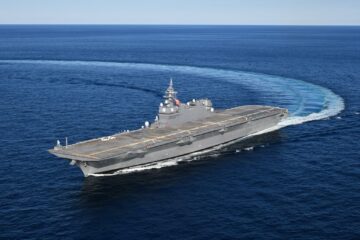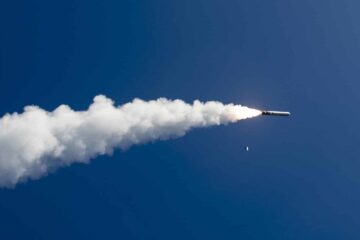The defense budget request, which will be sent to the finance ministry to consider before making a decision in December, calls for strengthening the nation’s integrated air and missile defense system and stand-off defense capabilities to counter the growing military threats posed by China, North Korea and Russia.
The budget requests related to the maritime domain are as follow:
Construction of two Aegis system equipped vessels – ASEVs ($2.6 billion)

The defense ministry explained at its budget request for the next fiscal year 2024 that the new ships will be 190 meters long, 25 meters wide, and have a standard displacement of 12,000 tons. In comparison, the two Maya-class Aegis-equipped destroyers are 170 meters long, 21 meters wide, and have a standard displacement of 8,200 tons.
The ministry pointed out that the size of the ASEV will be 1.7 times as large as that of the US Navy’s latest Flight III Arleigh Burke-class guided-missile destroyer.
The ASEV will have a crew complement of about 240, which is much fewer than the Maya-class destroyer’s 300 crewmembers.
The Japanese Maritime Self-Defense Force (JMSDF) is expected to take delivery of the first ASEV during fiscal year 2027, with the second one in the following fiscal year.
The ministry expects the construction cost per ASEV will be about $2.7 billion eventually.
As previously reported by Naval News, the configuration of the main armament used by the ASEV is similar to that of two Maya-class ships, including a Mk-45 (Mod.4) 5-inch/62-caliber (127mm) main gun, SM-3 Block IIA and SM-6 missiles.
The defense ministry said the new ships will be equipped with weapon systems such as a long-range, ship-launched, improved version of the Type 12 Surface-to-Ship Missile (SSM), U.S.-made Tomahawk cruise missiles, and high-power anti-drone laser systems starting from fiscal year 2032.
Construction of two new FFMs ($1.2 billion)

The defense ministry said it will acquire a total of 12 new FFMs that will succeed the Mogami-class FFM for the JMSDF.
The JMSDF had originally planned to build a total of 22 Mogami-class frigates as Tokyo ramps up efforts to strengthen the country’s naval forces.
However, JMSDF officials said it has decided to now procure a total of only 12 such frigates until 2023, with plans to construct a new class of 12 warships from 2024. The new frigates will be virtually improved Mogami-class ships.
The defense ministry said the new-class FFM will be fitted with longer-range missiles, enhanced anti-submarine capabilities, and improved capabilities for various maritime operations.
Specifically, the ship-launched, improved version of the Type 12 SSM and the new ship-to-air guided missile (or simply A-SAM) will be equipped with the new-class FFM, defense officials said
“The reason why the missile control was made independent is probably to accommodate the missiles that are planned to be installed in the future,” a former JMSDF official told Naval News.
With better anti-aircraft and search capabilities, the new FFM may become closer to the FFG (missile frigate).
The MoD documents, released by the MoD on August 31, said the new-class FFM has a standard displacement of 4,500 tons. Meanwhile, according to Mitsubishi Heavy Industries (MHI)’s proposal of the new-class FFM, which was officially released by the Japanese Acquisition, Technology & Logistics Agency (ATLA) on August 25, the new warship class will feature a heavier standard displacement of about 4,880 tons, a greater overall length of about 142 m, and a wider overall beam of about 17 m. The new vessels have a top speed of more than 30 kt, according to MHI’s proposal.
In comparison, the Mogami-class has an overall length of 132.5 m, an overall beam of 16.3 m, and displaces about 3,900 tons at standard loads.
Despite the fact the new class will be bigger than Mogami-class, defense officials said the new class’s crew complement will be only 90, the same as that of the Mogami-class. To achieve this, Japanese naval planners have likely incorporated the new class with a higher level of automation and deployed extensive lean-manning concepts throughout the vessel.
“Labor saving and manpower saving are the biggest challenges. How can we make use of the increased space distribution?” the former JMSDF official asked.
Modifications of Izumo-class helicopter carriers($290 million)

The Japan Maritime Self-Defense Force (JMSDF) asked for 42.3 billion yen ($290 million) to continue modifying its two Izumo-class helicopter carriers – JS Izumo and JS Kaga – into aircraft carriers capable of enabling Lockheed Martin F-35B fighter aircraft operations.
The JMSDF said 40.7 billion yen will be used to modify the bow section of JS Izumo’s flight deck a trapezoid into a square shape during fiscal year 2024, following JS Kaga’s same modifications during the current fiscal year 2023. A portion of the funds will be also used to equip Izumo with a landing navigation system for F-35Bs, which is set to be Raytheon’s Joint Precision Approach and Landing System (JPALS). Meanwhile, JS Kaga will receive modifications of its satellite communicator after undergoing major upgrades in fiscal year 2023.
The JMSDF said both ships will complete all of upgrades to become a light aircraft carrier operating F-35B fighters in fiscal year 2027.
Development of electronic warfare aircraft ($95.7 million)
The MoD said it will develop an electronic-warfare aircraft in order to respond to the increasingly complex electronic warfare environment and strengthen capabilities in the electromagnetic domain necessary for cross-domain operations.
The new aircraft will be developed based on the Kawasaki P-1 maritime patrol aircraft (MPA).
Co-development of the Glide Phase Interceptor (GPI) with the U.S.($512.7 million)

The two nations plan to complete this development in the early 2030s, defense officials in Tokyo said.
The Japanese side will be primarily responsible for the rocket motor and the propulsion system for the kill vehicle.
Japan and the United States agreed to start the joint development of the Glide Phase Interceptor (GPI). The announcement was made on 18 August by both the Japanese MoD and the U.S. Department of Defense (DoD) as US President Biden was hosting Japan’s Prime Minister Fumio Kishida and South Korea’s President Yoon Suk-yeol at Camp David.
Development of a new surface-to-ship/surface-to-surface precision guided missile ($218.7 million)

The ministry plans to develop a new surface-to-ship/surface-to-surface precision guided missile by fiscal year 2030, which will likely have much more longer range than existing missiles.
At DSEI Japan 2023, Kawasaki Heavy Industry (KHI) unveiled a new type of stealthy anti-ship missile called “Island defense anti-ship missile (島嶼防衛用新対艦誘導弾 in Japanese)”. This missile could be related.
Acquisition of maneuverable boats ($118.3 million)

In order to secure capabilities for swift and reliable transportation of necessary units to defeat the invasion of islands to the southwest region, the MoD will procure three maneuverable boats during the next fiscal year. The ministry said the boats will be 35 meters long.
The MoD plans to hold competitive bidding after it secures the budget. In order to operate those new boats, a new “Self-Defense Force Maritime Transport Flotilla” (tentative name) will be established at the Japan Maritime Self-Defense Force Kure Base as a joint army, naval and air force in March 2025. The number of members at the flotilla will be about 100 from the three services, according the MoD.
At DSEI Japan 2023, BMT was showcasing a model of its CAIMAN-90 for this program.
Construction of a new replenishment ship ($566 million)


The MoD requested 82.5 billion yen ($566 million) to build a 14,500-tonne replenishment ship, which will strengthen logistical support capabilities on the sea for other JMSDF vessels in any situation. It is scheduled to be delivered in fiscal year 2028. The new ship will be the successor of JS Towada (AOE-422), according to the MoD.
Research on combat support multipurpose USV ($168 million)

Selectively equipped with functions such as warning and surveillance and anti-ship missile launch, Researching stealth USVs that support manned ships.
Development of unmanned amphibious vehicle ($145 million)

Landing is possible from all fronts on the islands, allowing troops to land nearby from the sea. Development of an unmanned amphibious vehicle that can carry out missions such as transporting supplies has begun.
Trial operation of USV (test equipment) ($110 million)
In order to quickly acquire knowledge of USV operation and promote the development of domestically produced USVs, the Japanese defense budget calls for the procurement of USVs that have been used in various countries as test equipment.
Research and development on UUV for ocean observation ($1.3 million)
In order to improve the efficiency of ocean observation:
Conducting research and research on UUV (for underwater topography observation and acoustic characteristics investigation), which is currently being considered for introduction.
Conducted performance tests using UUV (for observation of water temperature structure, etc.) test equipment procured in FY2021.
Story by Kosuke Takahashi, editing by Xavier Vavasseur






